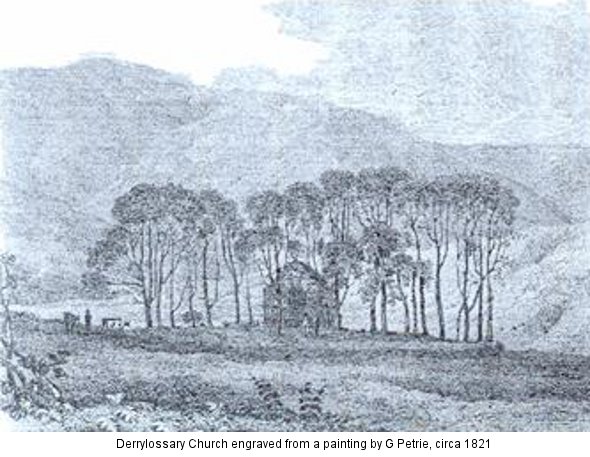Journal Volume 5 2006
Derrylossary Churchyard and 1798 Monument
By Pat Power
Derrylossary Churchyard

The name Derrylossary is probably derived from 'doire lisheen'meaning the 'little enclosure of oak'. And indeed the location of the site suggests such an origin. The church is built on an ancient site and there may well be remains of a pre-Reformation church under the present structure. Three 'bullaun stones' are associated with the graveyard. These items generally attest to a long established religious site. The best example of the Derrylossary bullaun stones is the one preserved in the graveyard enclosure. It is a large granite monolith with a grind hole 15” wide by 12” deep. A smaller depression was probably the cradle for the grinding stone (now lost). The purpose of bullaun stones is still debatable but the general consensus for those in proximity to old churches is that they were corn grinders for the ritual grinding of a portion of the ancient church corn tithe. This dates from a time, 10th century onwards, when it was the custom for local people to gather and present their first fruits and a portion of farm produce to the clergy. In 1932 the antiquarian Liam Price reported a very old baptismal font, said to have originated from the church, located in the garden of a private house near Annamoe.

The now roofless church consists of two distinct buildings. The older section, which comprises of the nave of the existing church dates from the late 11h century and is depicted in George Petrie's illustration of Derrylossary Church executed for engraving in Thomas Cromwell's Excursions Through Ireland (1820-21). Here the small church is shown from a southerly aspect surrounded by a grove of mature trees. Contemporary guidebooks remarked on the ‘melancholy air'of the place under their dense foliage. A few fragments of the trees still exist.
The main portion of the present building was a standard type Established Church with bell tower built in 1820 for £450 pounds, funded in part by the parishioners and the Board of First Fruits. A few scattered gravestones are shown in the engraving. Derrylossary churchyard contains, as well as its memorials of the Protestant church tradition, a number of Roman Catholic gravestones from the 1740's to 1750's when ‘respectable' Catholics were allowed burial in Established Church graveyards. This reflects the time before the Roman Catholic Church was allowed to legally own its own property and when some Established Church congregations, like that at Derrylossary, allowed Catholic interments. Invariably Catholic memorials in Protestant graveyards were always placed in the rear of the church out of immediate sight.
The oldest traceable grave memorial still existing is to the Rev Arthur O'Neill and dates from 1705, just about the time when family gravestones were first coming into fashion for those outside the military or nobility. Other early 18th century stones are to the Hatton family (1712) Fleming (1715) Williams (1732) Kana (1740) Carroll (1746) Kennedy (1778) and several others from a later period of the 18th century.
Buried in Derrylossary Churchyard are two important figures from the loyalist side of the 1798 rebellion. Thomas Hugo of Drumeen House who died of natural causes in 1809 was associated with the legendry rebel figure General Joseph Holt. During the course of the Rebellion they were sworn enemies and much of the lore surrounding Joseph Holt in the latter part of '98 centres on his quarrels with Hugo, who's house at Drumeen was burned by Holt. Here too is buried Rev Ambrose Weekes, Rector of Annamoe, who was also burned out in the rebellion.


